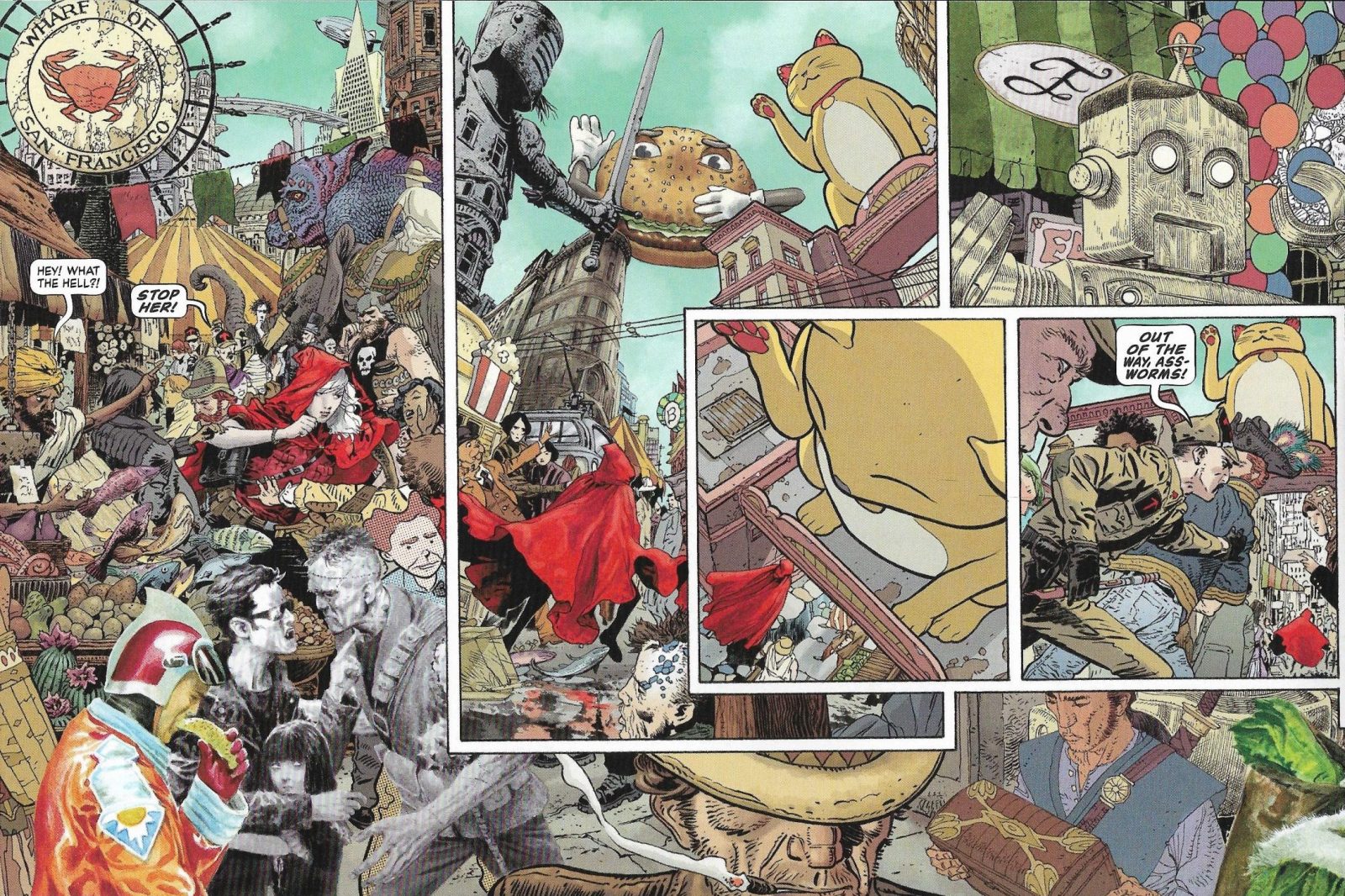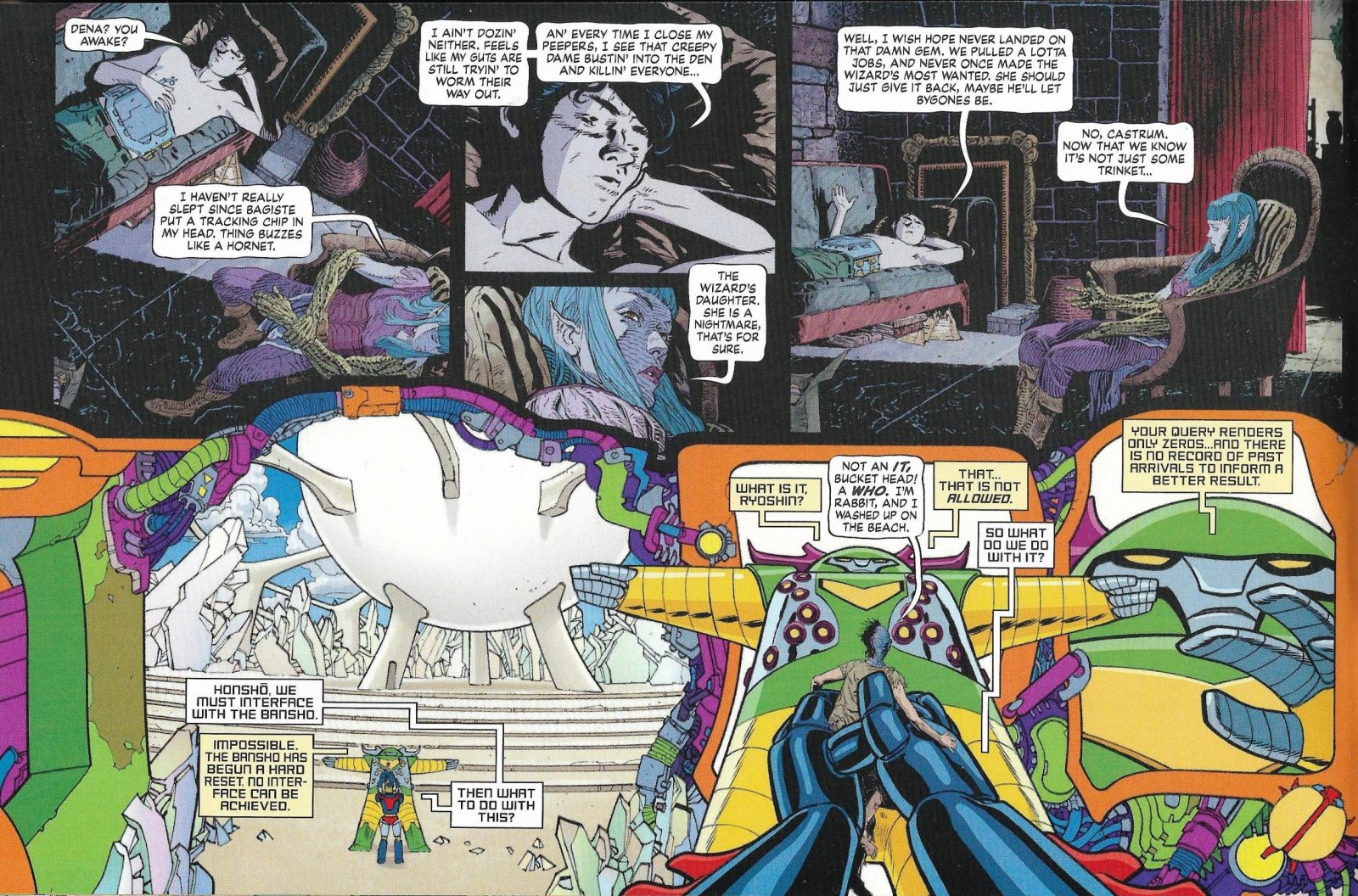EDITOR'S NOTE: This review is based on the six extant individual issues of the Echolands comic book series; a collected edition of these same issues has just been released.
* * *
When writing a fantasy story, there are two ways to introduce readers to your sprawling make-believe world. One is to present a massive info dump right up front, explaining in detail–whether through third-person narration or clunky dialogue–the extended history of the world you’ve created, its various rules and regulations, and how all the characters relate to each other. Think of the text scrawl at the start of the Star Wars movies or the intro to Peter Jackson’s The Fellowship of the Ring.
The other way is to just throw readers right into the middle of the story, explain nothing, and hope that folks are clever enough to figure out how everything relates and what exactly is going on through the various contextual clues and occasional bits of exposition left for them (one supposes) to suss out as the story progresses.
In their new ongoing series Echolands, co-creators J.H. Williams III and W. Haden Blackman (who co-writes) have bravely chosen the latter format, but it’s unfortunately also a choice that dooms the series, as there’s no entry point for readers to care about the characters or what’s going on.

Williams shouldn’t need much, if any, introduction to the folks that peruse this website. On series like Batwoman, Promethea, Desolation Jones and The Sandman: Overture, he has continually proven himself to be one of the most interesting and inventive artists working in mainstream comics today, consistently creating inventive page designs, or altering his style markedly in order to heighten various emotional and narrative beats. He is someone who thinks about the page as a unique unit in addition to being concerned about basic panel-to-panel transitions. Any look at the bulk of superhero comics on the market today will show you how rare a quality that is.
Echolands’ story concerns one Hope Redhood, a fairytale type of character (she wears a red hood, in case the name wasn’t enough of a giveaway) with magic head-exploding powers who lives in a world teeming with every type of genre character a la the series Top 10, which Williams' Promethea collaborator Alan Moore created with Gene Ha & Zander Cannon. Hope has stolen a MacGuffin from the evil wizard that rules the city and he’s none too pleased about its loss, forcing her and her loose band of cohorts to go on the run, jumping place to place under constant threat of attack.
Williams’ artistry is on full display in Echolands. Adopting a landscape format instead of the traditional 8.5" x 11" comic book orientation, each lush, elaborate page seems to be set upon providing you with a new design, a different way to move your eye. Here’s one where the panels look like stones in a wall! Here’s one where we follow a drone as it zips in and around panels! Williams is constantly looking for ways to mix up the layout, like having two competing storylines split down the middle on most pages of issue #5. And there are also lots of cute little Easter Eggs, like having the number of each chapter “hidden” in its first double-page splash.
If that’s not enough, Williams draws each character in a different manner. The elvish character, for instance, is rendered with a thin, spidery line, reminiscent perhaps of P. Craig Russell. A Frankenstein monster looks like he just stepped out of a Bernie Wrightson sketchbook, gray wash tones and all. The ruler of Treasure Island is an obvious Jack Kirby homage. The anime-themed robots that live in one area look quite different from the denizens of the vampire kingdom. And one of Hope's tag-along friends looks like an odd cross between Harold Teen and Dagwood Bumstead.

And yet despite all this inventive design and thoughtful construction, Echolands feels depressingly inert. There is nothing here to hang your hat on, mainly because the entire cast of characters has, to a man, the personality of drab wallpaper. Williams & Blackman spend much time scurrying everyone around from place to place (a sea monster attack here, flying off in a rocket ship there, etc.), but precious little developing interest or affection for Hope and her gang beyond hints and suggested secrets among them. Six chapters in, I know nothing more about these characters than I did at the start. Despite the various genre swipes, there’s not even the broad stereotypes you see in most action comics. “Here’s the smart one.” “This one cracks jokes.” Everyone in this cast is a cipher.
That makes them a tough lot to sympathize with. As far as I can tell, Hope stole the wizard’s mysterious gewgaw for little more than a laugh, an action that put her friends at severe risk and results in several deaths and maimings. At multiple points in the story various characters ask why they are sticking with a woman who has put them all in deadly danger, and why they don’t just abandon her; all I could think was “yeah, why don’t they?” The authors provide no real reason for the continued allegiance. There’s no sense of friendship or fondness among this group.
It doesn’t help that each chapter is so brief. The shortness of each episode is understandable though – the high quality and amount of detail on each page of Echolands no doubt requires a considerable investment of time. But the filler that rounds out the last quarter of each issue–a multi-part Rolling Stone-style interview with the aforementioned evil wizard, letters pages, and a lengthy list of alllllll the music Williams listened to while drawing–just underscores the thinness of the story on which it all leans.
There’s a chance is all a long, slow burn, and that Echolands will come into its own in its second part, with the sort of characterization and story detail the first so badly lacks. As it currently stands, however, this is a very vibrant and visually-stunning series about which it is nigh-impossible to muster any enthusiasm.









